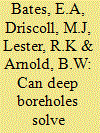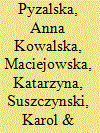|
|
|
Sort Order |
|
|
|
Items / Page
|
|
|
|
|
|
|
| Srl | Item |
| 1 |
ID:
132610


|
|
|
|
|
| Publication |
2014.
|
| Summary/Abstract |
The United States is in need of a new and more adaptive long-term strategy for spent nuclear fuel. In this communication, we outline the fundamental reasons why deep borehole disposal should receive more detailed investigation, alongside traditional shallow mined repositories. This potential solution is supported by advancing drilling technologies and an improving understanding of extremely long fluid residence times in deep bedrock. Radionuclide isolation is supported by verifiable and stable geologic barriers such as long transport distances to aquifers, low permeability, and reducing chemical conditions. The modular nature of implementing deep borehole disposal could offer unique programmatic and economic advantages. Experience with a pilot borehole program will be required to confirm the feasibility of drilling and emplacement operations, and key chemical and hydraulic conditions.
|
|
|
|
|
|
|
|
|
|
|
|
|
|
|
|
| 2 |
ID:
142037


|
|
|
|
|
| Summary/Abstract |
In 2002, a Nuclear Security Culture (NSC) Enhancement Program with the mission to raise the level of the NSC at sites and facilities in Russia's nuclear complex was launched under the guidance of the Russian State Corporation “ROSATOM” and with support from the US Department of Energy. A Joint Working Group for NSC with both Russian Federation and US members was formed and charged with the design and implementation of the program. The program was implemented at sites and facilities on a pilot basis. Nine sites participated in the Pilot Project. The key program component was an establishment of Culture Coordinators (CCs) with the authority to coordinate and implement NSC enhancement activities at sites and facilities. The CCs have served as the force that has maintained the momentum of the Pilot Project and continuously steered the site NSC enhancement efforts. The contribution of the CCs in achieving the positive outcomes of the program cannot be overstated.
|
|
|
|
|
|
|
|
|
|
|
|
|
|
|
|
| 3 |
ID:
132608


|
|
|
|
|
| Publication |
2014.
|
| Summary/Abstract |
Using an agent-based modeling approach we study the temporal dynamics of consumer opinions regarding switching to dynamic electricity tariffs and the actual decisions to switch. We assume that the decision to switch is based on the unanimity of ? past opinions. The resulting model offers a hypothetical, yet plausible explanation of why there is such a big discrepancy between consumer opinions, as measured by market surveys, and the actual participation in pilot programs and the adoption of dynamic tariffs. We argue that due to the high indifference level in today×s retail electricity markets, customer opinions are very unstable and change frequently. The conducted simulation study shows that reducing the indifference level can result in narrowing the intention-behavior gap. A similar effect can be achieved by decreasing the decision time that a consumer takes to make a decision.
|
|
|
|
|
|
|
|
|
|
|
|
|
|
|
|
| 4 |
ID:
131450


|
|
|
|
|
| Publication |
2013.
|
| Summary/Abstract |
In 1946, American architect Albert Mayer began a pilot project in "village reconstruction" for India. The resulting Etawah project in the northern Indian state of Uttar Pradesh helped inspire a national program in India and appeared as a model to U.S. policy makers, international organizations, and postcolonial leaders seeking to align peasants to elite development goals. Although it would be swept up in Cold War ambitions and in Cold War historiography, Etawah was not just a Cold War project or even simply an American or Indian project. Over time, Indians colluded with Americans in the erasure of Etawah's transnational roots and rewrote the pilot project for a range of, often contradictory, purposes. Unpacking the many versions of Etawah reveals that the origins of development as a field are to be found in transnational interchanges, contending national, imperial, and disciplinary visions, and conscious efforts to shape its meaning.
|
|
|
|
|
|
|
|
|
|
|
|
|
|
|
|
|
|
|
|
|